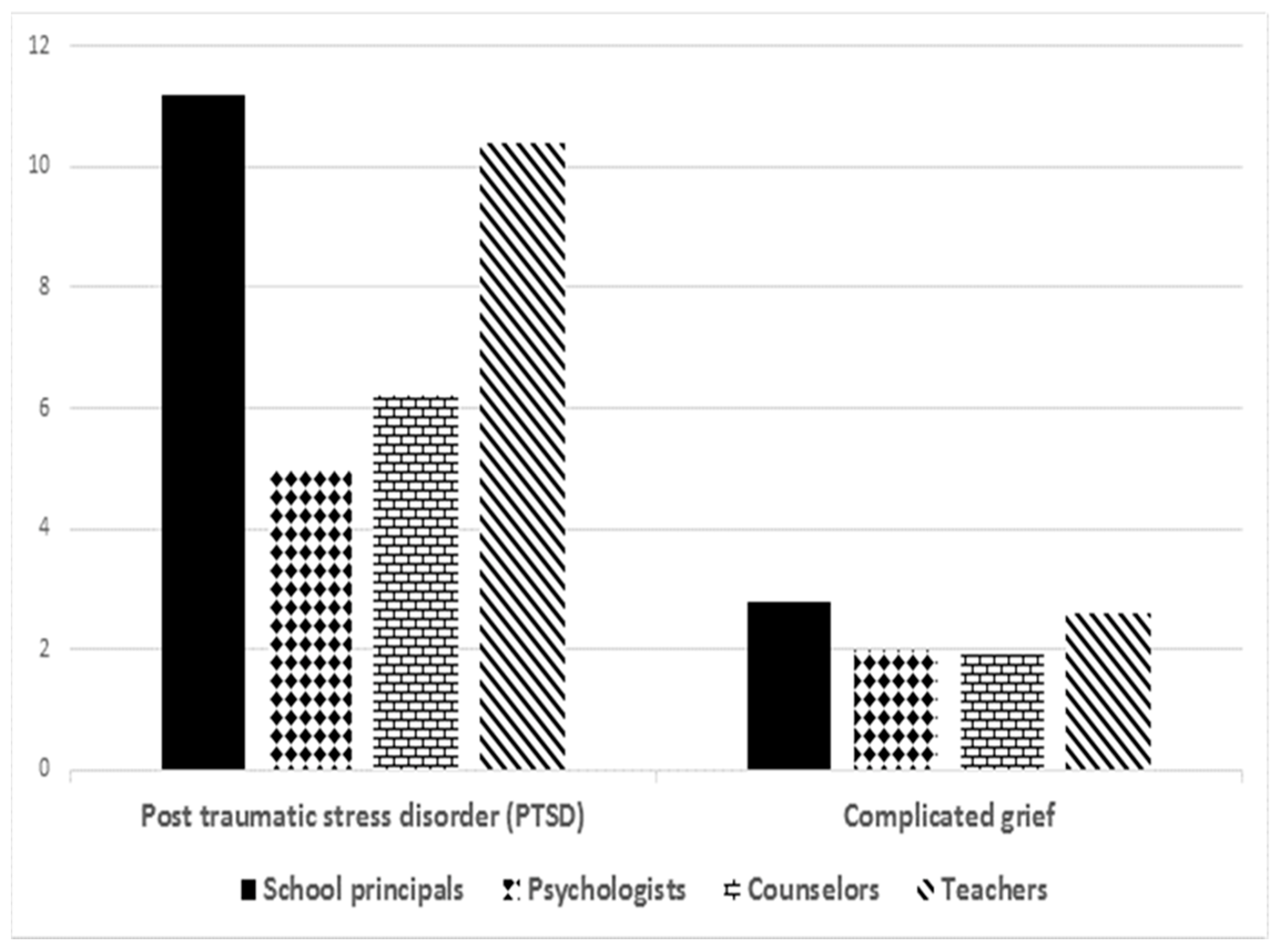The “Forgotten Grievers”: The Impact of Pupil Suicide on Post-Trauma and Grief Symptoms in School Staff
Abstract
:Highlights
- Following a suicide of a pupil principals and home-room teachers suffer more from complicated grief and PTSD compared to psychologists and counsellors.
- Principals and home-room teachers should receive more preparatory training.
Abstract
1. Introduction
2. Materials and Methods
2.1. Subjects
2.2. Procedure
2.3. Tools
2.4. Statistical Methods
3. Results
4. Discussion
5. Limitations
6. Conclusions
Author Contributions
Funding
Institutional Review Board Statement
Informed Consent Statement
Data Availability Statement
Conflicts of Interest
References
- Levi-Belz, Y. Stress-related growth among suicide survivors: The role of interpersonal and cognitive factors. Arch. Suicide Res. 2015, 19, 305. [Google Scholar] [CrossRef] [PubMed]
- Swihart, J.; Silliman, B.; McNeil, J. Death of a student: Implications for secondary school counselors. Sch. Couns. 1992, 40, 55–60. [Google Scholar]
- Wasserman, D.; Hoven, C.W.; Wasserman, C.; Wall, M.; Eisenberg, R.; Hadlaczky, G.; Kelleher, I.; Sarchiapone, M.; Apter, A.; Balazs, J.; et al. School-based suicide prevention programmes: The SEYLE cluster-randomised, controlled trial. Lancet 2015, 385, 1536–1544. [Google Scholar] [CrossRef]
- McLoughlin, A.B.; Gould, M.S.; Malone, K.M. Global trends in teenage suicide: 2003–2014. QJM 2015, 108, 765–780. [Google Scholar] [CrossRef] [PubMed]
- Cerel, J.; Maple, M.; van de Venne, J.; Moore, M.; Flaherty, C.; Brown, M. Exposure to Suicide in the Community: Prevalence and Correlates in One, U.S. State. Public Health Rep. 2016, 131, 100–107. [Google Scholar] [CrossRef] [PubMed]
- Cerel, J.; Padgett, J.H.; Conwell, Y.; Reed, G.A. A call for research: The need to better understand the impact of support groups for suicide survivors. Suicide Life Threat. Behav. 2009, 39, 269–281. [Google Scholar] [CrossRef] [PubMed]
- Gibbons, R.; Brand, A.; Carbonnier, A.; Croft, A.; Lascelles, K.; Wolfart, G.; Hawton, K. Effects of patient suicide on psychiatrists: Survey of experiences and support required. BJPsych Bull. 2019, 43, 236–241. [Google Scholar] [CrossRef]
- Chemtob, C.M.; Hamada, R.S.; Bauer, G.; Kinney, B.; Torigoe, R.Y. Patients’ suicides: Frequency and impact on psychiatrists. Am. J. Psychiatry 1988, 145, 224–228. [Google Scholar] [PubMed]
- Sandford, D.M.; Kirtley, O.J.; Thaites, R.; O’Connor, R.C. The impact on mental health practitioners of the death of apatient by suicide: A systematic review. Clin. Psychol. Psychother. 2021, 28, 261–294. [Google Scholar]
- Christianson, C.L.; Everall, R.D. Constructing bridges of support: School counsellors’ experiences of student suicide. Can. J. Coun. Psychother. 2009, 42, 209–221. [Google Scholar]
- Avney Rosha Institute. Expected Outcomes from School Principals at the Start of Their Career. Available online: http://www.avneyrosha.org.il/eng/Documents/Expected_outcomes.pdf.2010 (accessed on 19 July 2022).
- Zarad, E. Knesset Report on Teachers in the Israeli Educational System. 25 June 2019. Available online: https://fs.knesset.gov.il/globaldocs/MMM/fa83866a-6e5b-e911-80e9-00155d0aeebb/2_fa83866a-6e5b-e911-80e9-00155d0aeebb_11_13503.pdf (accessed on 19 July 2022).
- Foa, E.B. Posttraumatic Diagnostic Scale Manual; National Computer Systems: Minneapolis, MN, USA, 1996. [Google Scholar]
- Prigerson, H.G.; Bierhals, A.J.; Kasl, S.V.; Reynolds, C.F., 3rd; Shear, M.K.; Newsom, J.T.; Jacobs, S. Complicated grief as a disorder distinct from bereavement-related depression and anxiety: A replication study. Am. J. Psychiatry 1996, 153, 1484–1486. [Google Scholar] [CrossRef] [PubMed]
- Cooksey, R.W. Illustrating Statistical Procedures: Finding Meaning in Quantitative Data; Springer: Singapore, 2020. [Google Scholar] [CrossRef]
- Bickel, R. Multilevel Analysis for Applied Research; The Guilford Press: New York, NY, USA, 2007; p. 272. [Google Scholar]
- Lazenby, R.B. Teachers Dealing with the Death of Students: A Qualitative Analysis. J. Hosp. Palliat. Nurs. 2006, 8, 50–56. [Google Scholar] [CrossRef]
- Munson, L.J.; Hunt, N. Teachers grieve! What can we do for our colleagues and ourselves when a student dies? Teach. Except. Child. 2005, 37, 48–51. [Google Scholar] [CrossRef]
- Rowling, L. The disenfranchised grief of teachers. OMEGA-J. Death Dying 1995, 31, 317–329. [Google Scholar] [CrossRef]
- Oplatka, I. Learning the principal’s future internal career experiences: An assessment of a unique principal preparation programme in Israel. Int J. Educ. Manag. 2009, 23, 129–144. [Google Scholar] [CrossRef]
- Sisask, M.; Värnik, P.; Värnik, A.; Apter, A.; Balazs, J.; Balint, M.; Bobes, J.; Brunner, R.; Corcoran, P.; Cozman, D.; et al. Teacher satisfaction with school and psychological well-being affects their readiness to help children with mental health problems. Health Educ. J. 2013, 74, 382–393. [Google Scholar] [CrossRef]
- Liora, F. School Management Under Conditions of Terror and Ongoing Trauma; Ahva College of Education: Beer-Tuvia, Israel, 2008. (In Hebrew) [Google Scholar]
- Bonanno, G.A.; Kaltman, S. The varieties of grief experience. Clin. Psychol. Rev. 2001, 21, 705–734. [Google Scholar] [CrossRef]
- Israel Ministry of Education Director General Directive, Educational Counselor. Outline of Educational Psychology Services (Hebrew). Available online: https://cms.education.gov.il/EducationCMS/Units/Sherut/Takanon/Perek5/Yoetz/ (accessed on 16 July 2022).
- Tiech-Fire, N.; Alkalay, S.; Gvion, Y.; Zalsman, G. The association between school staff’s coping strategies following a student’s suicide, school climate, and previous experience with suicide. Br. Educ. Psychol. 2022; under review. [Google Scholar]
- Anastasi, A. Psychological Testing, 6th ed.; The Open University: Tel Aviv, Israel, 1990. (In Hebrew) [Google Scholar]

Publisher’s Note: MDPI stays neutral with regard to jurisdictional claims in published maps and institutional affiliations. |
© 2022 by the authors. Licensee MDPI, Basel, Switzerland. This article is an open access article distributed under the terms and conditions of the Creative Commons Attribution (CC BY) license (https://creativecommons.org/licenses/by/4.0/).
Share and Cite
Tiech Fire, N.; Gvion, Y.; Alkalay, S.; Zalsman, G. The “Forgotten Grievers”: The Impact of Pupil Suicide on Post-Trauma and Grief Symptoms in School Staff. Int. J. Environ. Res. Public Health 2022, 19, 12160. https://doi.org/10.3390/ijerph191912160
Tiech Fire N, Gvion Y, Alkalay S, Zalsman G. The “Forgotten Grievers”: The Impact of Pupil Suicide on Post-Trauma and Grief Symptoms in School Staff. International Journal of Environmental Research and Public Health. 2022; 19(19):12160. https://doi.org/10.3390/ijerph191912160
Chicago/Turabian StyleTiech Fire, Noa, Yari Gvion, Sarit Alkalay, and Gil Zalsman. 2022. "The “Forgotten Grievers”: The Impact of Pupil Suicide on Post-Trauma and Grief Symptoms in School Staff" International Journal of Environmental Research and Public Health 19, no. 19: 12160. https://doi.org/10.3390/ijerph191912160



